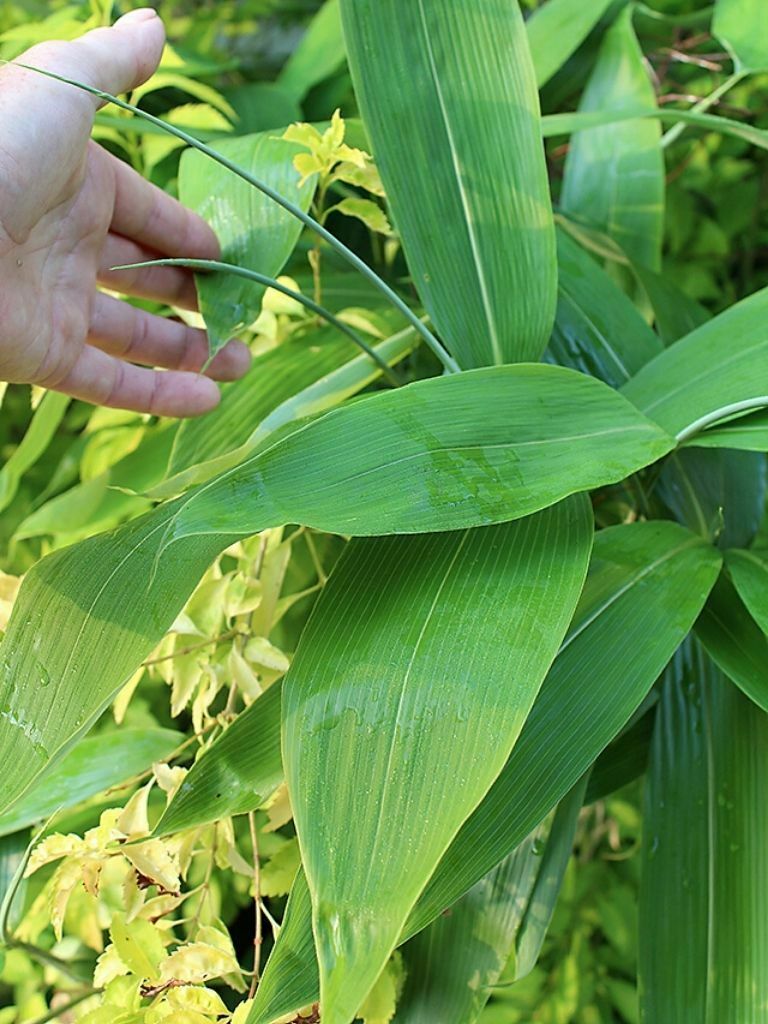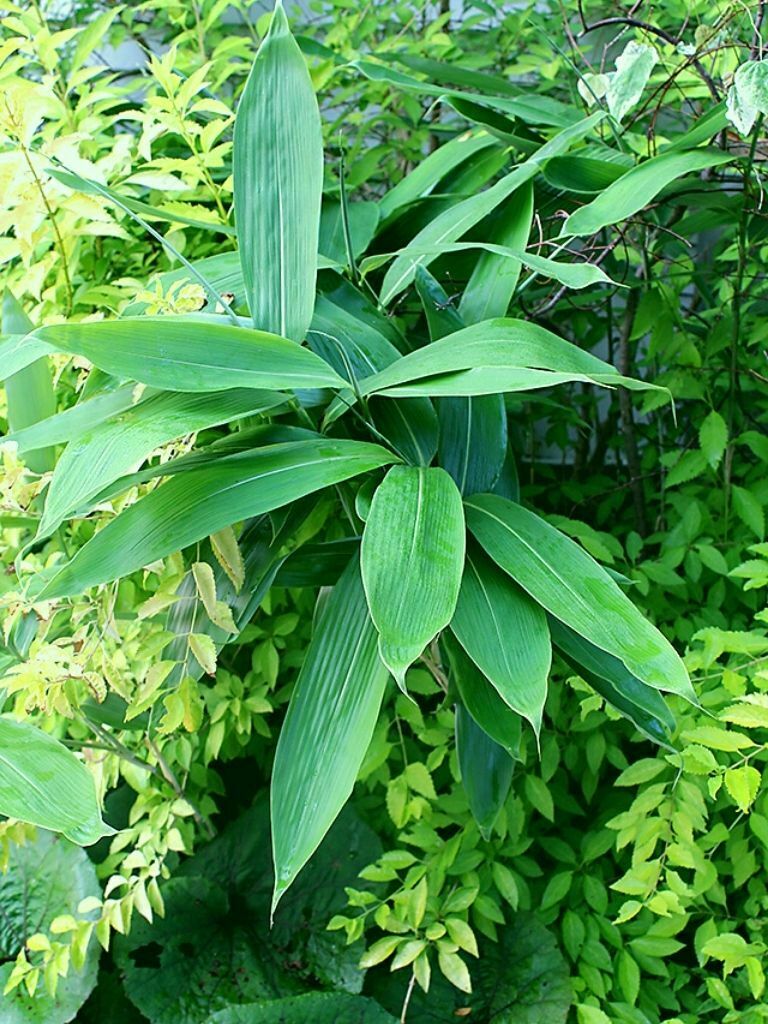More extensive than big: No bamboo leaves are larger than those of Indocalamus tessellatus. No matter that this is bamboo that thrives in Boston, it brings the look of Borneo to your garden year-round.
My colony thrives amid a large gold-leaf forsythia, which is an excellent contrast in color as well as texture: the bamboo’s enormous leaves look as big as palm fronds.
And both are very happy in the morning sun of this narrow bed on the north side of the house. You can also grow indocalamus tessellatus (large-leaved bamboo) in full sun, but my hunch is that it will get larger leaflets in the shade.
My leaves, as bodacious as they look, are actually on the small side this year, barely a foot long. Leaves can be twice as long on colonies that are older and are growing where there’s minimal Winter damage. But I cut the entire colony to the ground in the Spring, which was a quicker response to a hard Winter than clipping just this leaflet or that.
These marvelous but smaller leaves on shorter-than-usual canes are “just” the rebound growth.
As so often in gardens, it’s the Winter drainage that’s key: I know of a colony growing 40 miles North of here that’s twice as tall as mine. And, yup, its site is drier all Winter long.
To have this bamboo at any height, from two feet to ten, is a joy for gardeners from Boston to Boca.
Here’s How To Grow Indocalamus Tessellatus:
Latin Name:
Common Name:
Big-leaved Bamboo
Family
Poaceae, the Grass family.
What kind of plant is it?
Evergreen running bamboo.
Hardiness
Zones 6 – 9.
Habit
Upright, spreading into large colonies unless contained. Full to the ground.
Rate of Growth
Fast.
Size in ten years
A clump ten feet across and eight feet tall—even wider and taller in milder climates.
Texture
Tropical and dense.
Grown for:
its uniquely large leaves, which are, by far, the largest of any bamboo. Individual leaflets can be two feet long and four inches wide—many times the size of “normal” bamboo.
Its tolerance of shade. This is a stunning bamboo to grow under high deciduous trees, or (as I do) on the north side of a building, where it gets only some morning sun.
Its prowess as a soil-binder and erosion-controller. This is a talent that all running bamboos share. (In Japan, a country always on the verge of being overrun with bamboos of all sorts, the country wisdom is to run into the nearest bamboo grove in an earthquake, where the terrain, solidly bound together by the bamboo rhizomes, is less likely to be sundered beneath you.)
But Indocalamus tessellatus is particularly suited to erosion control because of its dense foliage and large leaves, which diffuse even the most torrential rain.
Its leaves’ unpalatability to deer, a surprise has given their immense size. That said, deer sometimes take a liking to the soft new canes themselves, which take much of the Summer to form. So this isn’t the bamboo for a heavily-deered property.
Its full-to-the-ground habit and the mature height of six to ten feet, which make it potentially, an excellent choice for screening. Need to hide all your garbage cans? The neighbor’s chain-link dog run? Big-leaf Bamboo could be the answer.
Its Winter-interest importance as a broad-leaf evergreen.
Flowering season
All bamboo is, typically, monocarpic, flowering just once and then dying. (The species survive only through the germination of the resultant seeds.) Individual plants sometimes recover from flowering, but don’t count on it: Flowering is something to regret, not rejoice in.
Happily, the “generation time” between flowering episodes, depending on the species, can be many years or even generations.
Some bamboo has never been recorded as flowering, even after a couple of centuries of cultivation. I don’t know of a resource that lists the generation times of the bamboos, let alone where we are in the flowering cycle of any particular one of them.
All of the bamboos of a given species worldwide tend to flower in about the same year or two. In any event, “flowering” is far too pretty a word; bamboo flowers aren’t showy any more than the flowers of your lawn grass.
Culture
Indocalamus tessellatus is very tolerant, growing in almost any reasonable soil that isn’t bone dry in Summer or poorly drained in the Winter. As a rule, bamboos don’t tolerate wet feet in the Winter and, indeed, will not cross, let alone colonize, freshwater.
Bamboos are happy, though, to be growing right alongside water as long as they’re safely above it. Then they can dip their roots into it but still keep their horizontal underground runners dry.
Indocalamus will thrive in full sun as well as part-shade; I can’t prove it, but my hunch is that the already huge leaflets are even more significant in the shade. Yippee!
How to handle growing it?
Indocalamus tessellatus is but one of the many garden-worthy bamboos that, alas, are not tidy and timid clumpers. They are very appropriately called “runners” and would like nothing better than taking over the neighborhood. The first goal for any gardener who craves running bamboo, then, is to be sure that you’ll be able to control the ever-adventurous underground rhizomes.
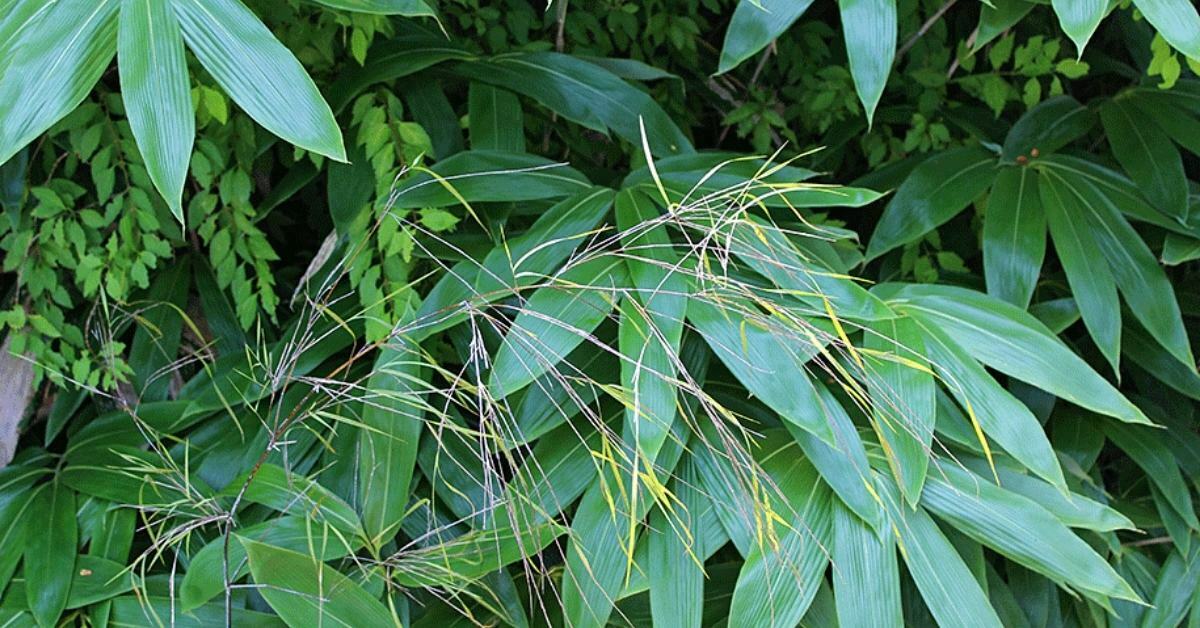
Here are a couple of tactics for success:
- Bamboo can be “moated” by lawn grass that you mow, provided it’s at least ten feet wide. Twenty is even better. The tender new canes are cut off by the mower and don’t grow back: All of their growth potentials are at the very tip of the cane.
- Bamboo’s abhorrence of permanently wet soil means that boggy ground or open (fresh) water are themselves a natural barrier. All bamboos look elegant by open water, so pond- or stream-side planting is practical as well as gorgeous.
- To have running bamboo growing where you can use neither mow around it nor bound it with water—like, say, as a screen at your property line—means that you’d have to put in an underground barrier. This is a lot of work, and therefore expense—and often is unsuccessful, to boot. The best barrier is, of course, also the most expensive: A poured-concrete foundation wall. On the other hand, this means that bamboos can be beautiful as well as safely partnered with buildings with poured-concrete foundations. Alas, bamboo can eventually grow under and out the other side of a concrete pad of a terrace, let alone a standard-width concrete walkway. In the Deep South, bamboo can pierce right through asphalt.
- The last method I use for this Indocalamus colony: Whenever a cane pops up too far afield, I feel around between it and the mother colony to find the underground rhizome that sprouted it. The rhizomes are very shallow, so this is quick as well as easy.
And then I cut the rhizome with hand pruners and—with glee—pull it up, foot by foot, following it ever-outward into the garden. The rhizomes always grow far beyond where they’ve started to announce themselves by shooting up the vertical canes.
So the yank-up is a bit of a treasure hunt, and on my hands and knees, too. My record so far? A rhizome that had stealthily crept outward six feet past its last offending cane.
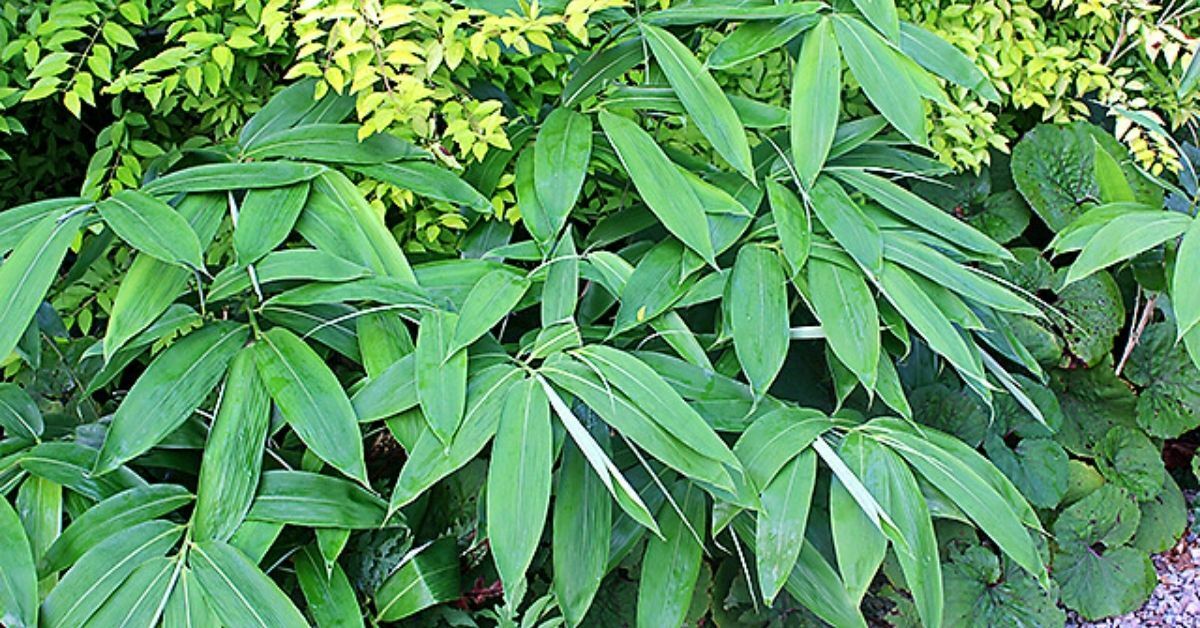
Aside from controlling the underground spread of the rhizomes, your next chore is to help your bamboo handle Winter’s worst and recover from it quickly the following Spring and Summer. Try to get outside in a blizzard or ice-storm (fun, eh?) to keep ice and snow from weighing the bamboo canes to the ground.
They recover but can block sidewalks and driveways in the meantime. In late Winter and early Spring, before the new canes start shooting, cut dead or Winter-damaged canes right to the ground. If your Winters are habitually severe, you could just make a practice of cutting your entire bamboo colony to the ground in, say, early April. The new growth in
May and June will quickly give you new lush growth.
Downsides
Running bamboos need strategic siting (see How to Handle it) if they’re not to become a pest.
Variants
While there are a couple of other Dendrocalamus, I. tessellatus has the most giant leaves by far. I’d be hard-pressed to grow more than one Indocalamus. There are scores of other bamboos to tempt you, though, dozens hardy into Zone 6, and some even down to Zone 5.
Mature heights can range from under a foot to many yards tall—even, in older colonies in the milder end of their range, several stories tall. Some bamboos have leaves that are very showily striped or edged in white or yellow. Others have canes that are notably yellow, brown, black, bulbous, contorted, or mottled.
There are also (thank goodness) bamboos that don’t run; these are called, appropriately, the clumpers. Most are (alas) tender in New England, with the sole exception of the many fargesias.
To my eye, every garden in Zone 7 and 6 should have Indocalamus tessellatus; one or more of the fargesias (which can vary a lot in their mature sizes); one or even several of the variegated smaller-size bamboos like Pleioblastus or Sasa; and one of the taller “forest” bamboos like Phyllostachys.
Propagation
By division.
Native habitat
Japan.
Bamboo Foliage: the Alpha & Omega
Leaves of big-leaved bamboo are the largest: up to two feet long. Despite its tropical size, it’s hard to coastal Maine. Among the smallest leaves of any bamboo are those of Mexican weeping bamboo. The day it was headed to the greenhouse for the Winter, I had set the container specimen in front of my colony of big-leaved before loading it into the truck.
The contrast of their differing foliage sizes could hardly be more striking. Below, a couple of leaves of Otatea acuminata var. aztecorum resting on my palm.
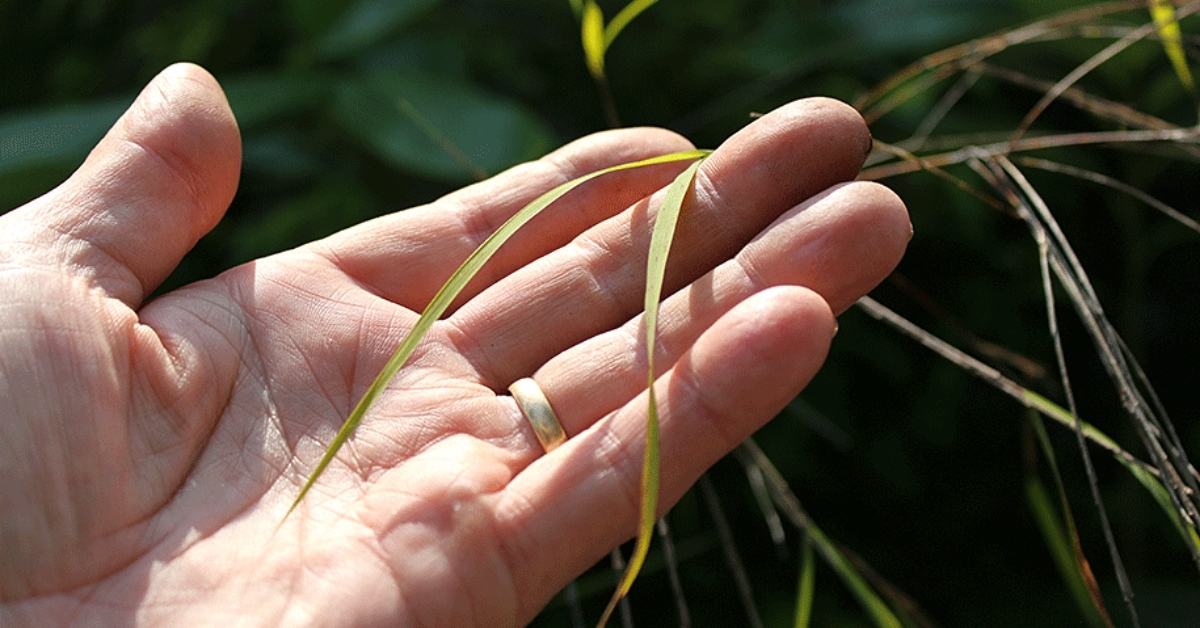
Below, just a single leaf of Indocalamus tessellatus is far more than any three or four hands my size could grasp fully.
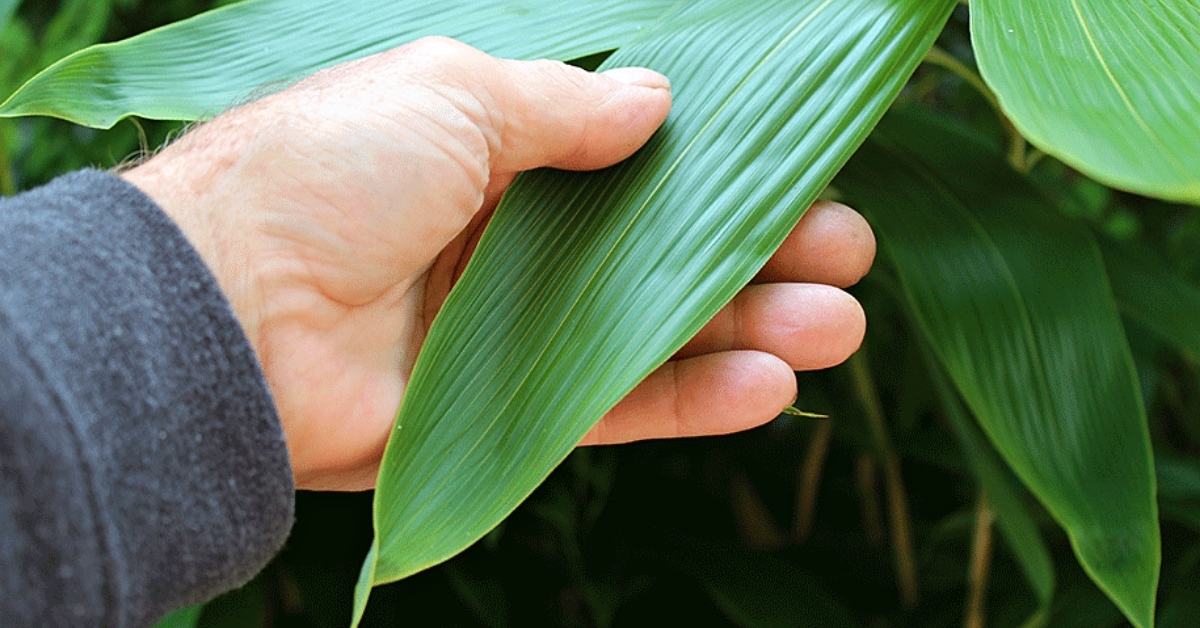
The two species also contrast sharply inhabit as well as hardiness. As befitting its native habitat in Mexico and Central America, Otatea is subtropical: It’s hardy only to Zone 9 and, so, is a container specimen here in Zone 6. As is so often the case with tender bamboos here, it’s also a clumper, not a runner. Heights of twenty feet are not unusual.
In Summer and Fall, the foliage of big-leaf bamboo—the largest of any bamboo, tender or hardy, big or small, young or old—looks lush and tropical. Today’s temperatures are single-digit, and they’ll be even slimmer tonight and tomorrow. They are the worst Winter can bring, yet the big-leaf bamboo looks just the same: Lush and tropical.
How can foliage of Indocalamus tessallatus persist in such good shape through such a deep freeze?
That’s the easy question to answer: All evergreen foliage survives sub-freezing temperatures by reducing its amount of water and reducing it so much that there’re too few water molecules, compared to all the other stuff in the leaf—the structural components of the leaf, the carbohydrates, the amino acids, the chlorophyll—to glom together and freeze.
All that other stuff gets in the way of the formation of ice crystals; for the purposes of Winter survival, it’s just so much antifreeze.
The next question is the puzzle. How could the retention of enormous green foliage be a wise strategy for any plant hoping to survive until warm weather returns?
Most really-hardy evergreens are conifers, whose leaves have comparatively little internal volume compared to their surface area. (Think about pine needle: It has very little internal space, and that space is all extremely near the outer surface of the needle.)
You’d think that having all that external surface so close to the internal volume of the needle would make it fewer Winter-proof, not more. Wouldn’t any remaining water be evaporated or, literally, blown right out of the thin needle by high winds?
It turns out that the high proportion of surface area to internal volume is a plus: Surface area must mean surface structure, the rigid and freeze-proof walls, and “I-beams” of the leaf that enables it to hold its shape and prevent damage from high winds.
The minimal internal volume is “antifreeze” by being saturated with oils—the fragrant resins are so typical of conifers. And the outer surface of the needle has a waxy coating, the cuticle, that stops evaporation due to high wind. (Yes, the needles also have “breathing holes”—stomata—but they close in cold weather.)
But the leaves of big-leaf bamboo are huge—up to two feet long and four inches wide—and would seem to have none of the advantages of the pine needles. No problem: Bamboo foliage has other strategies and even other goals. It is peculiarly rigid, just like bamboo canes themselves, because it has a high proportion of silica, a compound the bamboo forms as it absorbs the element silicon through its roots.
Silica makes the fibers of the bamboo flexible yet extremely strong. The foliage, as well. High wind, heavy ice, or snow? They are all unable to penetrate or even damage the bamboo’s leaves or canes.
The bamboo leaves also reduce their proportion of water, achieving still more resistance to freezing.
But these helpful “winterizing” aren’t the real answer to the survival of the huge bamboo leaves. Bizarrely, that survival isn’t much of a goal at all. It’s accidental. Regardless of whether this current crop of foliage and canes survives in the Winter, the bamboo colony will send up a fresh crop of canes in Spring.
The vigor of that new crop doesn’t depend on the longevity of the current crop. Bamboo lives by a motto that’s the title of the famous novel of Milan Kundera: “Life is Elsewhere.” It doesn’t matter how horrible the Winter is for the colony’s above-ground growth; as long as the underground portion—the rhizomes—isn’t frozen too severely, the colony will survive unimpeded.
From the bamboo’s perspective, then, who cares how—or even whether—that lush and tropical-looking foliage gets through the Winter? It’s irrelevant. Only evergreen-hungry gardeners appreciate the accidental persistence of the foliage, even after many weeks of snows and deep freezes.
By February and March, the foliage’s endurance will have become exhausted. The leaves’ ability to retain even the modest amount of water needed to keep the chlorophyll green will have been decreased and degraded. The tips of the leaves are already showing a bit of wear and tear; by March, they will be largely tawny.
Any time the look of the foliage becomes too tattered—and the weather is mild enough to work outside, or I just want to be outside all bundled up—I can cut the canes to the ground without worrying that the bamboo colony is being depleted or diminished by their absence.
They were already unimportant to the colony back in December. The show of evergreenity since then has been a gift. An inadvertent one, true.
